NOW is the Time for Potato Planting in North Texas
Digging Deeper: Growing Potatoes
Most potato varieties are not grown from seeds, but rather from “seed potatoes”, or small potatoes grown specifically for the purpose of propagating new potato plants! Unlike store bought potatoes, seed potatoes are certified to be pest and disease free, and have not been sprayed with any growth retardants. (which might deter the natural sprouting process)
Grocery store potatoes are often treated with sprout inhibitors to prevent them from sprouting in the store, and helps to prevent spoilage while in storage. Retail potatoes may also be more likely to contain fungal pathogens, which could be spread into the garden, if planted. Additionally, while a few cultivars, common at the grocery store, can indeed be successfully grown in Texas—many others are not well adapted to the, often harsh, climate and soils of North Texas. Check out our list below of some of the best potato cultivars adapted to North Texas gardens!
Site Selection:
For best production, potatoes need full sun (or at least 6 hours of sunlight). They prefer loose, well-draining, soils which are slightly acidic. Poorly drained alkaline clay soils (most common in North Texas) often contribute to lower yields and cause the tubers to be smaller.
Amending our native clay soils with compost, and/or expanded shale can create conditions with better drainage– and lighter soils, more favorable for potato production. Raised beds or containers, filled with sandy loam, also work well for growing potatoes in our region.
For best results, plant in February to early March or when soil temperatures reach 50 F at a depth of 4” deep.
How to Plant Seed Potatoes
-
- Cut seed potatoes in half, or in several pieces if desired. Potatoes are best grown from pieces of potatoes with at least one or two “eyes.” The eyes are the active growing points where the new growth will sprout. The smallest potatoes can also just be planted whole in the soil.
-
- If possible, set aside freshly cut potatoes for 4-6 days, to allow newly exposed flesh to dry and callus over. This helps prevent soil-borne diseases from infecting your potato crop through the newly exposed flesh. Alternatively, they can be dipped in powdered sulfur, or wood fireplace ash to speed up drying, and help form a protective coating. Callusing is especially important if growing in the heavy clay native soils common in North Texas.
-
- Space each seed potato 10-15” apart at a depth of about 3”4” deep.
-
- Topdress with a balanced slow-release organic fertilizer, per label instructions. Reapply when plants are 6-8” tall.
-
- If desired, mound soil or “hill” around the base of the plant as the young shoot/stem continues to grow.
Watering
Maintain even moisture throughout the growing process, with a goal of damp (not wet) soil. In cooler wet weather, less supplemental irrigation is necessary. As temperatures warm, and on windier days, they will require more water. A light layer of straw or pine straw mulch will reduce water lost through evaporation. Consider investing in and inexpensive soil moisture meter to help gage watering needs. Overwatering poorer draining soils can contribute to increased fungal issues.
Harvesting
Potatoes are typically ready to harvest (May/June) when the tops begin to yellow/die–and when the potato skin becomes firm. (around 90-100 days after planting) The skin is set when it does not scrape easily when rubbed with the thumb. Speed up skin setting by cutting back the tops of the plants, and then waiting a few days to harvest.
To harvest, start by feeling around (with your hands) the base of the plant for potatoes near the the surface. Carefully dig around the base with a trowel to lift the tubers out of the soil, being very careful not to damage the skins. Use your other hand to feel for potatoes below the surface, then grasp the whole plant at the base and gently tug it free of the soil. Next, dig around in the loosened soil for more potatoes using either your hand or a trowel. If any potatoes are inadvertently damaged during the harvest, eat those first. Gently dust off excess soil and store potatoes in a cool dry place. (avoid washing if possible– or wash AND dry completely before storing)
Popular Well-Adapted Cultivars (in stock Now at Rooted In)
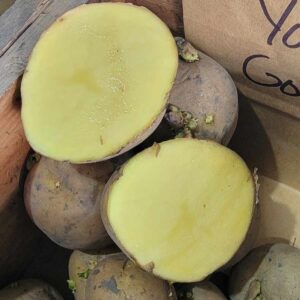
Yukon Gold- a very popular early season potato created as a cross between white and yellow potatoes. They are a larger cultivar with a smooth, slightly waxy skin, and yellowish flesh. Yukons have a creamy texture and buttery flavor, making them ideal for mashing, boiling, baking, and frying. 100 days to harvest.
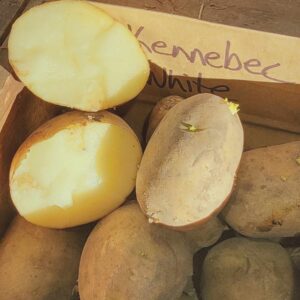
Kennebec- a popular well-adapted, all-purpose potato with thin, tan-colored skins and smooth textured, white flesh. Kennebecs produce dependably high yields, and the plants exhibit good disease resistance. When harvested at the new potato stage, Kennebec potatoes are ideal for whipping/creaming. When full-sized, round to oblong spuds perfect for frying, boiling, mashing or baking. They can be harvested young, around 70 to 80 days after sowing, or full-grown, around 90 to 120 days.
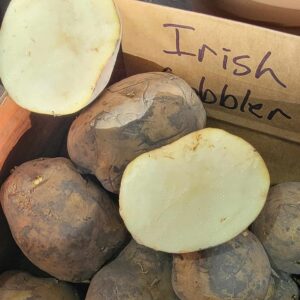
Irish Cobbler- a medium sized, brown skinned, white-fleshed heirloom variety first introduced in the 1870s and prized as an early-producing potato of high edible value. Great for mashed potatoes and potato soups! Early season maturity, 80 days.
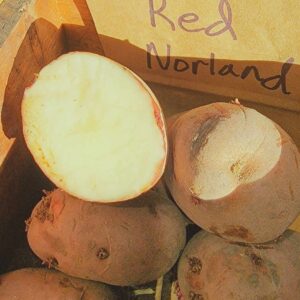
Red Norland- produces white-fleshed, medium to large tubers with smooth thin red skin, shallow eyes and great flavor. They store well and are moderately resistant to scab. This variety was first developed at North Dakota State University for northern climates but is well-adapted to Texas, producing high yields.
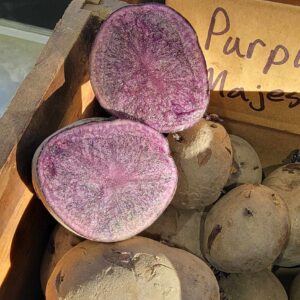
Purple Majesty- a small to medium-sized heirloom potato, prized for their intense purple flesh. They are widely regarded as having better flavor than other purple varieties and keep their rich color when cooked. Pigmented potatoes like Purple Majesty have been linked to decreased oxidative stress, inflammation, and improved immune status. Purple Majesty also offers excellent table quality with firm moist flesh and great flavor whether baked, boiled or fried. Midseason: 85-95 days